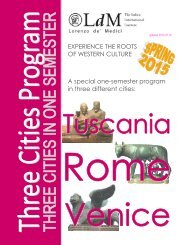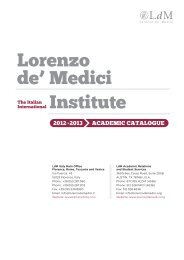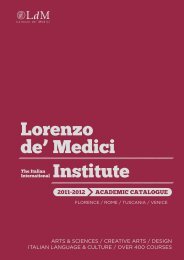aCademiC Catalog 2013-2014 - Lorenzo de Medici
aCademiC Catalog 2013-2014 - Lorenzo de Medici
aCademiC Catalog 2013-2014 - Lorenzo de Medici
You also want an ePaper? Increase the reach of your titles
YUMPU automatically turns print PDFs into web optimized ePapers that Google loves.
Exhibition Management<br />
ART 267 F<br />
Cr: 3; Contact hrs: 45<br />
In this course stu<strong>de</strong>nts learn the main procedures involved in<br />
planning and managing a museum exhibition. Most of the course<br />
revolves around the <strong>de</strong>velopment by each stu<strong>de</strong>nt of a complete<br />
and viable exhibition proposal. Major effort is <strong>de</strong>dicated to the<br />
proposal (research and <strong>de</strong>velopment), the budget plan (key<br />
elements and procedures), logistics and security (transport,<br />
insurance, timetables), promotion (marketing research and<br />
materials, sponsorship issues), physical planning (viewer flow,<br />
display principles), and curatorship (scholarly validity and<br />
impact, cataloguing and information, networking). The course<br />
taps into the remarkable world-class experience and innovation<br />
concentrated in Italy and especially Florence. The project may<br />
relate to a real space in Florence. Local spaces and temporary<br />
exhibitions are studied, and visits with specialists such as<br />
architects, exhibition <strong>de</strong>signers and museum curators, are<br />
special features of the course.<br />
Prerequisites: Art History or Restoration majors and sophomore<br />
standing<br />
The Genius of Michelangelo<br />
ART 270 F<br />
Cr: 3; Contact hrs: 45<br />
This course focuses on Michelangelo Buonarroti (1475-1564)<br />
and offers stu<strong>de</strong>nts the opportunity to explore in <strong>de</strong>pth the life<br />
and work of one of the most gifted and revolutionary artists<br />
of the sixteenth century. It will look on his long artistic career<br />
as a painter, sculptor, architect and poet. The artist’s personal<br />
and artistic relations with other outstanding artists of his time,<br />
in particular to Leonardo and Raphael, whom Michelangelo<br />
perceived as great rivals, will also be a central theme of the<br />
course. The course will be based on recent literature, sources<br />
of the time and Michelangelo’s own writings (mainly his letters<br />
and poetry). It will also explore artistic questions like the<br />
hid<strong>de</strong>n meanings in his works and Michelangelo’s influence on<br />
contemporary and later artists. The course will also explore<br />
relations with his commissioners, especially the <strong>Medici</strong> in<br />
Florence and the papal court in Rome un<strong>de</strong>r pope Julius II.<br />
Stu<strong>de</strong>nts will gain a <strong>de</strong>tailed knowledge of Michelangelo’s work,<br />
and will be able to i<strong>de</strong>ntify and analyze major works in painting,<br />
sculpture and architecture. Site visits will form an essential part<br />
of the course.<br />
Prerequisites: ART 180 Art History I, or ART 186 Art History II,<br />
or equivalents<br />
Materials and Techniques: from Antiquity to<br />
the Renaissance<br />
ART 272 F<br />
Cr: 3; Contact hrs: 45<br />
The course aims to provi<strong>de</strong> stu<strong>de</strong>nts with a basic background<br />
about various materials and techniques used in art from Antiquity<br />
up to the Renaissance, from painting on panel and canvas, to<br />
the fresco, from the lost wax bronze casting to the creation of<br />
hard-stone inlay, metal work and printmaking. Very often, in the<br />
study of art history, the main artistic techniques are neglected,<br />
if not completely ignored, while these were, on the contrary,<br />
very important in the creation of the greatest masterpieces that<br />
we still can admire. Using Powerpoint presentations, vi<strong>de</strong>os,<br />
and Renaissance sources, by authors like Cennino Cennini,<br />
Benvenuto Cellini and Giorgio Vasari, the course will analyze<br />
various artistic processes, <strong>de</strong>monstrating how they contributed<br />
to the final artistic result. Visits to museums and especially to<br />
local craft shops, as well as showing stu<strong>de</strong>nts the materials,<br />
tools and the way these have been used by the Renaissance<br />
artists will be an essential part of the course.<br />
Prerequisites: ART 180 Art History I, or ART 186 Art History II,<br />
or equivalents<br />
Italian Renaissance Art<br />
ART 278 F<br />
Cr: 3; Contact hrs: 45<br />
Florence, “the cradle of the Renaissance”, is the setting for this<br />
introduction to the history of Renaissance art. The course is<br />
inten<strong>de</strong>d to give the beginning stu<strong>de</strong>nt a general overview of the<br />
main facts, causes and conditions that led artists from Giotto in<br />
the fourteenth century to Masaccio, Donatello, Brunelleschi and<br />
Botticelli in the fifteenth century, up to Leonardo, Michelangelo<br />
and Raphael in the sixteenth century, to create one of the most<br />
fascinating periods in art history. In Italy these years witnessed<br />
an extraordinary coming together of artistic talent, a passionate<br />
interest in antiquity, civic pri<strong>de</strong> and an optimistic belief in “man<br />
as the measure of all things”. This course examines the most<br />
important monuments from the Renaissance period in Italy and<br />
the major artists and architects who contributed to the birth<br />
of western art. Works are always compared with each other to<br />
show various relationships, remembering how important it is to<br />
view Renaissance art in the context of its creation.<br />
Prerequisites: ART 180 Art History I, or ART 186 Art History II,<br />
or equivalents<br />
Lifestyle in Renaissance Florence<br />
ART 280 F; Dual listed: HIS 280 F<br />
Cr: 3; Contact hrs: 45<br />
Important Renaissance works of art, paintings, sculptures,<br />
and art objects like wedding chests and furniture, ceramics,<br />
and jewels and luxurious clothing are often characterized<br />
by coats of arms, by family, individual, or wedding emblems,<br />
and by symbols that are <strong>de</strong>eply related to their powerful<br />
commissioners (such as the <strong>Medici</strong>, Rucellai, Strozzi, and Pitti<br />
families in Florence). The course will illustrate and investigate<br />
their possible meanings and connections with history, families,<br />
and artists of the Renaissance, as well as with philosophy,<br />
astrology, and iconography from the end of the 15th to the 16th<br />
century.<br />
Italian Villas and Gar<strong>de</strong>ns<br />
ART 282 F<br />
Cr: 3; Contact hrs: 45<br />
This course examines the <strong>de</strong>velopment of Italian villa and<br />
gar<strong>de</strong>n architecture from ancient Roman times to the present.<br />
This course covers these artistic periods: 1) Ancient Rome;<br />
2) Medieval; 3) Renaissance and Mannerism; 4) Baroque;<br />
5) Romantic; 6) Mo<strong>de</strong>rn. Special emphasis is placed on the<br />
Renaissance, and on Florentine, Tuscan and Roman villas and<br />
gar<strong>de</strong>ns. Lectures and visits illuminate the intimate relationship<br />
between the villa, its formal gar<strong>de</strong>ns, and the surrounding<br />
environment. The course examines structures and grounds in<br />
terms of architectural <strong>de</strong>sign, typical features of each period<br />
(paintings and statues, fountains, grottoes, plants), and<br />
conceptual and symbolic meanings. The course will also explore<br />
the social and aesthetic function of villas and gar<strong>de</strong>ns: “magic<br />
places” in which nature and culture, work and pleasure meet.<br />
The aim of this course is to offer stu<strong>de</strong>nts a comprehensive look<br />
at the history and character of Italian villas and gar<strong>de</strong>ns, in the<br />
process familiarizing them with Italian ways of life and thought.<br />
Prerequisites: ART 165 History of Architecture, or ART 180 Art<br />
History I, or ART 186 Art History II, or equivalents<br />
Medieval Art<br />
ART 285 F<br />
Cr: 3; Contact hrs: 45<br />
The course <strong>de</strong>als with Early Christian and Medieval art, and<br />
its political, social and cultural implications. Topics discussed<br />
range from the origins of Christian art to Carolingian art; from<br />
proto-Romanesque art to the <strong>de</strong>velopment of Romanesque<br />
art in Europe; from classicism in Florentine Romanesque art<br />
to the Gothic style in architecture and sculpture. The course<br />
inclu<strong>de</strong>s a <strong>de</strong>tailed study of Italian Gothic painting: the schools<br />
of Siena and Florence, as well as Giotto’s works. The particular<br />
Florentine experience during the Gothic period and the social,<br />
political, economic, and cultural implications that form the<br />
background of Renaissance civilization, will be consi<strong>de</strong>red.<br />
Stu<strong>de</strong>nts gain un<strong>de</strong>rstanding of the vitality and variety of<br />
art in the Middle Ages. Visits to Romanesque, Gothic, and<br />
Renaissance monuments help to un<strong>de</strong>rstand the transitions,<br />
either linked to or in contrast with earlier styles.<br />
Prerequisites: ART 180 Art History I, or ART 186 Art History II,<br />
or equivalents<br />
Contemporary Architecture<br />
ART 286 F; Dual listed: ARC 286 F<br />
Cr: 3; Contact hrs: 45<br />
School of Arts & Sciences FLORENCE<br />
LdM Aca<strong>de</strong>mic <strong>Catalog</strong> <strong>2013</strong>-<strong>2014</strong><br />
53





